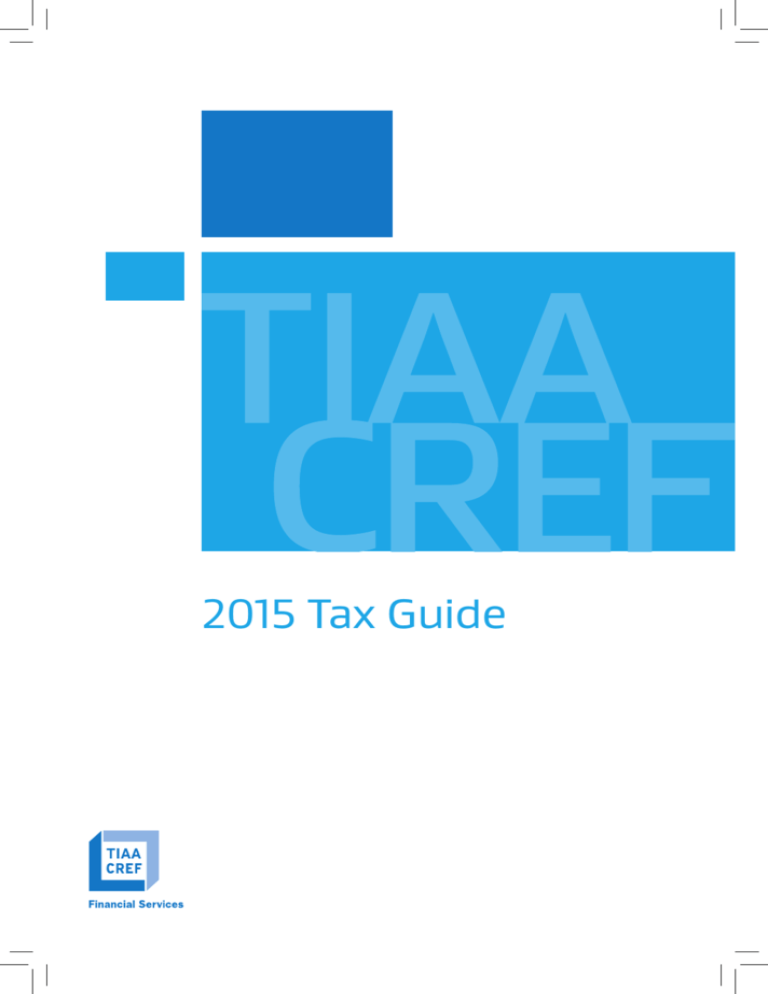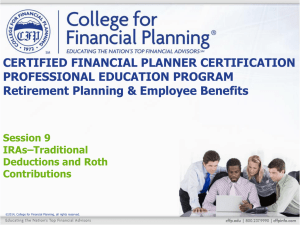2015 Tax Guide - TIAA-CREF
advertisement

2015 Tax Guide Table of contents 2 Federal income tax rates 4 Child credits 5 Taxes: estates, gifts, Social Security 1 2 Required minimum distributions 13 Roths 15 SEPs, Keoghs 6 Rules on retirement plans 16Coverdell accounts 8 Saver’s credit 17 How to contact us 9 IRA tax deductions Keep pace with tax law changes. The following discussion on federal income and other taxes is for general informational purposes only—it is not meant to be used, and cannot be used, by individuals to avoid federal, state or local tax penalties. Taxation varies depending on an individual’s circumstances, tax status and transaction type; the general information provided in this guide does not cover every situation—for complete information on your personal tax situation, you should always consult with a qualified tax advisor. While TIAA-CREF does not offer tax advice, we are familiar with certain tax situations that face our clients regularly. Connect with one of our experienced financial consultants. By phone Call us at 800 842-2252, Monday to Friday, 8 a.m. to 10 p.m., and Saturday, 9 a.m. to 6 p.m. (ET). Online Visit tiaa-cref.org to send us an email message by clicking “Contact Us” at the top of the home page. In person Arrange an appointment for an individual financial counseling session at www.tiaa-cref.org/ScheduleNow. Or visit www.tiaa-cref.org/local to locate a TIAA-CREF office in your area. TIAA-CREF 2015 Tax Guide 1 2015 Federal income tax rates Married individuals filing joint returns and surviving spouses If taxable income is: Not over $18,450 The tax is: 10% of the taxable income Over $18,450 but not over $74,900 Over $74,900 but not over $151,200 Over $151,200 but not over $230,450 $1,845 plus 15% of the excess over $18,450 $10,312.50 plus 25% of the excess over $74,900 $29,387.50 plus 28% of the excess over $151,200 Over $230,450 but not over $411,500 $51,577.50 plus 33% of the excess over $230,450 Over $411,500 but not over $464,850 $111,324 plus 35% of the excess over $411,500 $129,996.50 plus 39.6% of the excess over $464,850 Over $464,850 Single (other than surviving spouses and heads of households) If taxable income is: Not over $9,225 The tax is: 10% of the taxable income Over $9,225 but not over $37,450 $922.50 plus 15% of the excess over $9,225 Over $37,450 but not over $90,750 $5,156.25 plus 25% of the excess over $37,450 Over $90,750 but not over $189,300 $18,481.25 plus 28% of the excess over $90,750 $46,075.25 plus 33% of the excess over $189,300 Over $189,300 but not over $411,500 Over $411,500 not over $413,200 $119,401.25 plus 35% of the excess over $411,500 Over $413,200 $119,996.25 plus 39.6% of the excess over $413,200 Married filing separately If taxable income is: Not over $9,225 The tax is: 10% of the taxable income Over $9,225 but not over $37,450 Over $37,450 but not over $75,600 $922.50 plus 15% of the excess over $9,225 $5,156.25 plus 25% of the excess over $37,450 Over $75,600 but not over $115,225 $14,693.75 plus 28% of the excess over $75,600 Over $115,225 but not over $205,750 $25,788.75 plus 33% of the excess over $115,225 Over $205,750 but not over $232,425 $55,662 plus 35% of the excess over $205,750 Over $232,425 $64,989.25 plus 39.6% of the excess over $232,425 2 TIAA-CREF 2015 Tax Guide Heads of households If taxable income is: Not over $13,150 The tax is: 10% of the taxable income Over $13,150 but not over $50,200 $1,315 plus 15% of the excess over $13,150 Over $50,200 but not over $129,600 $6,872.50 plus 25% of the excess over $50,200 Over $129,600 but not over $209,850 $26,722.50 plus 28% of the excess over $129,600 Over $209,850 but not over $411,500 $49,192.50 plus 33% of the excess over $209,850 Over $411,500 not over $439,000 $115,737 plus 35% of the excess over $411,500 Over $439,000 $125,362 plus 39.6% of the excess over $439,000 Standard deduction Married filing jointly and surviving spouses $ 12,600 Single (other than surviving spouses and heads of households) $ 6,300 Heads of households $ 9,250 Married filing separately $ 6,300 Please note: For taxable years beginning in 2015, the additional deduction amount for those age 65 or over is $1,250, and an additional $1,250 for each qualified instance of blindness. The additional standard deduction amount is increased to $1,550 if the individual is also unmarried and not a surviving spouse. Taxpayers may receive a larger deduction if they itemize. Itemized deductions may include state and local income taxes, real estate taxes, mortgage interest, charitable donations, and unreimbursed allowable medical and dental expenses that is more than 10 percent of your adjusted gross income (AGI)—(waived if age 65 or older in 2013–2016). Personal exemptions For taxable years beginning in 2015, the personal exemption amount is $4,000. But beginning in 2015, the personal exemption is subject to a phase-out that begins with adjusted gross incomes of: WW $309,900 (Married filing jointly and surviving spouses) WW $284,050 (Heads of households) WW $258,250 (Single, other than surviving spouses and heads of households) WW $154,950 (Married filing separately) The personal exemption phases out completely with adjusted gross incomes of: WW $432,400 (Married filing jointly and surviving spouses) WW $406,550 (Heads of households) WW $380,750 (Single, other than surviving spouses and heads of households) WW $216,200 (Married filing separately) *A fter subtracting applicable standard or itemized deductions and personal exemptions from adjusted gross income. TIAA-CREF 2015 Tax Guide 3 Child care and dependent care credits You may be able to claim the child and dependent care credit if you paid “work-related expenses” for the care of a “qualifying individual.” The credit is generally a percentage of the amount of work-related expenses you paid to a care provider for the care of a qualifying individual. The percentage depends on your adjusted gross income. Work-related expenses qualifying for the credit are those paid for the care of a qualifying individual to enable you to work or actively look for work. The expenses qualifying for the credit must be reduced by the amount of any dependent care benefits provided by your employer that you exclude from gross income. The total expenses qualifying for the credit are capped at $3,000 (for one qualifying individual) or at $6,000 (for two or more qualifying individuals). For more information on who is a “qualifying individual,” you should consult with a qualified tax advisor. Maximum Credit Adjusted Gross Income Credit % One child Two or more children $15,000 and less 35% $1,050 $2,100 15,001 – 17,000 34 1,020 2,040 17,001 – 19,000 33 990 1,980 19,001 – 21,000 32 960 1,920 21,001 – 23,000 31 930 1,860 23,001 – 25,000 30 900 1,800 25,001 – 27,000 29 870 1,740 27,001 – 29,000 28 840 1,680 29,001 – 31,000 27 810 1,620 31,001 – 33,000 26 780 1,560 33,001 – 35,000 25 750 1,500 35,001 – 37,000 24 720 1,440 37,001 – 39,000 23 690 1,380 39,001 – 41,000 22 660 1,320 41,001 – 43,000 21 630 1,260 43,001 – no limit 20 600 1,200 4 TIAA-CREF 2015 Tax Guide Child tax credit The child tax credit is $1,000 for each “qualifying child” under the age of 17. The credit is subject to income limitations and may be reduced or eliminated depending on your filing status and income. A qualifying child is an individual for whom the taxpayer can claim a dependency exemption and who is a son, daughter, stepson or stepdaughter (or descendant of either), a brother, sister, stepbrother, or stepsister (or descendant of either) for whom the taxpayer cares as the taxpayer’s own child, or an eligible foster child of the taxpayer. The full credit is available to single parents with modified, adjusted gross incomes (AGIs) of $75,000 or less or to couples filing jointly with AGIs of $110,000 or less ($55,000 for married individuals who file separately). The credit is phased out for taxpayers whose AGIs exceed the limit at the rate of $50 of credit lost for every $1,000 of AGI in excess of the limit. For more information on who is a “qualifying child,” you should consult with a qualified tax advisor. Federal estate tax For 2015, the highest federal estate tax rate is 40% with a $5.43 million exemption. Federal gift tax For 2015, federal gift tax rules exclude the first $14,000 of an individual gift, but any excess amounts are subject to tax at the same rate as the individual federal income tax. The annual exclusion for gifts to spouses who are not U.S. citizens is $147,000. The lifetime gift tax exclusion is $5.43 million. TIAA-CREF 2015 Tax Guide 5 Social Security and Medicare tax rates Social Security Wage base FICA tax rate Self-employment tax rate $118,500 6.20% 15.3% 1.45% Medicare No Limit 2.90% The rates above do not include an additional 0.9% Medicare tax on earned individual income of more than $200,000 ($250,000 for married filing jointly). Social Security benefits The maximum Social Security benefit for a worker retiring at full retirement age (66 years old) in 2015 is $31,956. The benefit of a worker who retires at full retirement age is determined by calculating his or her Average Indexed Monthly Earnings (AIME), which is the career average of his or her annual covered earnings, adjusted for changes in average wage levels. If a worker retires before or after full retirement age, his or her AIME will be actuarially adjusted. Benefits are also reduced for retirees under full retirement age if their earnings exceed $15,720 a year (in 2015). In the year that a retiree reaches full retirement age, his or her earnings limit is higher ($41,880 for those who reach full retirement age in 2015). No limit applies in years following full retirement age. Rules on retirement plan contributions Annual retirement plan dollar limits Defined benefit plans $210,000* Defined contribution plans 53,000 Section 402(g) employee contributions to 403(b) and 401(k) plans 18,000 Section 457(b) plans 18,000 Keogh defined contribution plans 53,000 Age 50+ elective deferral catch-up contributions to 403(b), 401(k) and public/governmental 457(b) plans 6,000 *Cannot exceed the lesser of 100% of the participant’s average compensation for the highest three consecutive calendar years or $210,000. 6 TIAA-CREF 2015 Tax Guide Includible compensation limit The maximum amount of an individual’s compensation to take into account for purposes of nondiscrimination testing and calculating retirement plan contributions and benefits is generally $265,000 in 2015, but there are certain exceptions. For government plans, the $265,000 limit generally applies only to employees who became participants in the plan after the end of the 1995 plan year. For employees who are “grandfathered,” the compensation limit for 2015 is $395,000. Church plans that are exempt from nondiscrimination requirements are also exempt from the includible compensation limits. Age 50+ elective deferrals If participants age 50 and older are in both a public 457(b) plan and either a 403(b) or 401(k) plan, they can make $6,000 catch-up contributions to both plans. Withdrawals of elective deferrals Early withdrawal restrictions* A retirement plan participant may withdraw elective deferrals and earnings from 403(b), 457(b) public and 401(k) plans only after meeting one of the following triggering events: WW Attainment of age 59½ WW Separation from service WW Death WW Disability WW Hardship (only contributions, not earnings, may be withdrawn because of hardship) 10% additional tax Prior to reaching age 59½, a participant must meet certain qualifications to avoid the additional 10% tax penalty. These include, but are not limited to, if a participant: WW Separates from service at any age and begins annuity income, payable at least annually, for the life or life expectancy of the participant or the joint lives or joint life expectancies of the participant and beneficiary WW Separates from service during or after the year he or she reaches age 55 WW Has unreimbursed medical expenses to the extent that they exceed 10% of adjusted gross income WW Becomes disabled WW Makes a distribution to someone under a Qualified Domestic Relations Order (QDRO) * Also applies to all employee and employer contributions to a 403(b) plan. TIAA-CREF 2015 Tax Guide 7 Saver’s credit A nonrefundable tax credit is available to low and moderate income taxpayers who make contributions to 403(b), 401(k), governmental 457(b), SIMPLE or SEP employers’ retirement plans, or to Traditional or Roth IRAs. The credit can be claimed on the taxpayer’s tax return and applies to the first $2,000 in contributions to qualifying plans each year. The amount of the credit varies, depending on the amount contributed and the taxpayer’s filing status and adjusted gross income. The credit is available to individuals over age 17 except for dependents and full-time students. Married couples are both eligible for the credit. Cost-of-living adjustments apply in 2015. Married filing jointly Credit for contributions up to $2,000 Adjusted Gross Income 50% credit $ 0 – 36,500 20% credit 36,501 – 39,500 10% credit 39,501 – 61,000 0% credit 61,000 + Head of household Credit for contributions up to $2,000 Adjusted Gross Income 50% credit $ 0 – 27,375 20% credit 27,376 – 29,625 10% credit 29,626 – 45,750 0% credit 45,750 + Single filers and married filing separately Credit for contributions up to $2,000 50% credit Adjusted Gross Income $ 0 – 18,250 20% credit 18,251 – 19,750 10% credit 19,751 – 30,500 0% credit 8 TIAA-CREF 2015 Tax Guide 30,500 + Traditional Individual Retirement Accounts and annuities (IRAs) The Traditional IRA offers individuals up to the age of 701/2 the opportunity to set aside up to $5,500 of taxable compensation ($6,500 if you are age 50 or older) for 2015, receive an up-front tax deduction and accumulate tax-deferred investment earnings until withdrawal. Rules for Traditional IRA tax deductibility Single individual or head of household (doesn’t participate in any employer-sponsored retirement plan) Deduct the full amount from income as long as the taxable compensation is at least equal to the contributed amount. Single individual or head of household (participates in an employer-sponsored retirement plan) For 2014, deduct the full amount from income as long as (A) taxable compensation equals at least the contributed amount, and (B) the AGI for the tax year is $60,000 or less. Deduct a partial amount if AGI is between $60,000 and $70,000. For 2015, deduct the full amount from income as long as (A) taxable compensation equals at least the contributed amount, and (B) the AGI for the tax year is $61,000 or less. Deduct a partial amount if AGI is between $61,000 and $71,000. Married filing separately (one spouse participates in an employer-sponsored retirement plan) For both 2014 and 2015, deduct a partial amount from income if your AGI is less than $10,000. Married filing jointly (neither spouse participates in an employer-sponsored retirement plan) For both 2014 and 2015, deduct the full amount ($5,500 if under age 50, $6,500 if 50 or older) from income for each (a combined $11,000 to $13,000) regardless of combined AGI. TIAA-CREF 2015 Tax Guide 9 Rules for Traditional IRA tax deductibility (continued) Married filing jointly (both spouses participate in an employer-sponsored retirement plan) For 2014, deduct the full amount from income for each (a combined $11,000 to $13,000) as long as (A) you and your spouse’s combined taxable compensation is at least equal to the contributed amount, and (B) you and your spouse’s AGI for the tax year is $96,000 or less. Deduct a partial amount if you and your spouse’s AGI is between $96,000 and $116,000. For 2015, deduct the full amount from income for each (a combined $11,000 to $13,000) as long as (A) you and your spouse’s combined taxable compensation is at least equal to the contributed amount, and (B) you and your spouse’s AGI for the tax year is $98,000 or less. Deduct a partial amount if you and your spouse’s AGI is between $98,000 and $118,000. Married filing jointly (one spouse participates in an employer-sponsored retirement plan) For 2014, deduct the full amount ($5,500 if under age 50, $6,500 if 50 or older) from the participating spouse’s contribution as long as (A) you and your spouse’s combined taxable compensation is at least equal to the contributed amount, and (B) you and your spouse’s AGI for the tax year is $96,000 or less. Deduct a partial amount if you and your spouse’s AGI is between $96,000 and $116,000. For 2014, deduct the full amount ($5,500 if under age 50, $6,500 if 50 or older) from the nonparticipating spouse’s contribution as long as you and your spouse’s combined AGI does not exceed $181,000. Deduct a partial amount if you and your spouse’s AGI is between $181,000 and $191,000. For 2015, deduct the full amount ($5,500 if under age 50, $6,500 if 50 or older) from the participating spouse’s contribution as long as (A) you and your spouse’s combined taxable compensation is at least equal to the contributed amount, and (B) you and your spouse’s AGI for the tax year is $98,000 or less. Deduct a partial amount if you and your spouse’s AGI is between $98,000 and $118,000. For 2015, deduct the full amount ($5,500 if under age 50, $6,500 if 50 or older) from the nonparticipating spouse’s contribution as long as you and your spouse’s combined AGI does not exceed $183,000. Deduct a partial amount if you and your spouse’s AGI is between $183,000 and $193,000. 10 TIAA-CREF 2015 Tax Guide Maximum deductible Traditional IRA contribution for pension plan participants Spouse filing jointly; Both spouses participating Single taxpayers Adjusted Gross Income Maximum deductible contribution Adjusted Gross Income Maximum deductible contribution** $ 5,500 – 61,000 $ 5,500 $ 5,500* – 98,000 $ 5,500 62,000 4,950 100,000 4,950 63,000 4,400 102,000 4,400 64,000 3,850 104,000 3,850 65,000 3,300 106,000 3,300 66,000 2,750 108,000 2,750 67,000 2,200 110,000 2,200 68,000 1,650 112,000 1,650 69,000 1,100 114,000 1,100 70,000 550 116,000 550 71,000 + 0 118,000 + 0 Please note: This table assumes taxable compensation is at least equal to the otherwise deductible amount. * $11,000 if both spouses contribute ** For each spouse TIAA-CREF 2015 Tax Guide 11 How required minimum distributions are calculated When calculating required minimum distributions from retirement savings, divide the portion of the retirement savings that’s subject to the rules by the applicable life expectancy, which is called the Life Expectancy Divisor (LED). LED is a projection of how long a person at a given age will live, on average, based on the experience of a large group of people.† TIAA-CREF calculates the withdrawal amount using the Life Expectancy Divisor below as provided by the IRS.†† Life Expectancy Divisors (LED) Age LED Age LED Age LED 70 27.4 81 17.9 92 10.2 71 26.5 82 17.1 93 9.6 72 25.6 83 16.3 94 9.1 73 24.7 84 15.5 95 8.6 74 23.8 85 14.8 96 8.1 75 22.9 86 14.1 97 7.6 76 22.0 87 13.4 98 7.1 77 21.2 88 12.7 99 6.7 78 20.3 89 12.0 100 6.3 79 19.5 90 11.4 80 18.7 91 10.8 We’re required to estimate life expectancy using Internal Revenue Service (IRS) mortality tables. If you’re participating in a 403(b) plan, the initial withdrawal will be based on the account balance that has accumulated between December 31, 1986 and December 31 of the year prior to the year you turn age 701/2, or the year you retire, whichever is later. This amount is then divided by the life expectancy provided by the IRS. Life Expectancy Divisors are available for over 100 years of age. †† If your spouse is more than 10 years younger than you and is your sole primary beneficiary, we use your actual joint life expectancy recalculated annually to determine the divisor for minimum distribution withdrawals. † 12 TIAA-CREF 2015 Tax Guide Roth IRAs An individual whose income does not exceed the applicable income limit can generally contribute up to $5,500 ($6,500 if you are age 50 or older) a year to a Roth IRA, as long as your taxable compensation is at least $5,500. Roth IRA contributions can be made at any age, even after age 70½. If an individual contributes to both Traditional and Roth IRAs, the combined contributions are limited to $5,500 a year. Contributions to Roth IRAs are not deductible, but earnings are not taxed while they remain in these accounts. Withdrawals of earnings and contributions are free from federal tax if: 1. made five years after the Roth IRA was established, and 2. one of the following criteria is met: taxpayer attains age 59½, becomes disabled or dies, or uses $10,000 for a qualified first-time home purchase. Maximum Roth IRA contributions Single and head of household taxpayers Spouse filing jointly; (or qualified widow(er)s) Adjusted Gross Income Maximum Contribution Adjusted Gross Income Maximum Contribution** $ 5,500 - 116,000 $ 5,500 $ 5,500* - 183,000 $ 5,500 117,500 4,950 184,000 4,950 119,000 4,400 185,000 4,400 121,500 3,850 186,000 3,850 123,000 3,300 187,000 3,300 124,500 2,750 188,000 2,750 125,000 2,200 189,000 2,200 126,500 1,650 190,000 1,650 128,000 1,100 191,000 1,100 129,500 550 192,000 550 131,000 + 0 193,000 + 0 Please note: This table assumes taxable compensation is at least equal to the amount contributed and no contributions made to a Traditional IRA. Contribution limits for married individuals filing separately are phased out at AGIs between $0 and $11,000. *$11,000 if both spouses contribute **For each spouse TIAA-CREF 2015 Tax Guide 13 Roth IRA conversion rules Effective January 1, 2010, any taxpayer can convert or roll over an existing Traditional IRA and/or an eligible distribution from a tax-qualified plan (for example, 403(b), 401(k) or 457(b) Public Plan) into a Roth IRA.1 IRA One-Rollover-Per-Year Rule Beginning in 2015, you can make only one rollover from an IRA to another (or the same) IRA in any 12-month period, regardless of the number of IRAs you own. The limit will apply by aggregating all of an individual’s IRAs, including SEP and SIMPLE IRAs as well as traditional and Roth IRAs, effectively treating them as one IRA for purposes of the limit. Please NOTE: WW Trustee-to-trustee WW Rollovers transfers between IRAs are not limited from traditional to Roth IRAs (“conversions”) are not limited For additional information, please visit http://www.irs.gov/Retirement-Plans/IRA-One-Rollover-Per-Year-Rule. Roth 403(b) or 401(k) plan Sponsors of 403(b) and 401(k) retirement plans can offer participants the option of making some or all of their contributions in the form of after-tax Roth contributions instead of, or in addition to, pretax salary deferrals. Employees can’t take deductions for their Roth contributions, and any Roth contributions they make reduce the amount of pretax contributions they can make to the plan. Nevertheless, Roth contributions are likely to be quite attractive to some employees because qualified distributions are tax free. Contribution limits Roth contributions are considered to be a form of elective deferral and are subject to the same 402(g) limit as pretax elective deferrals ($18,000 plus $6,000 in catch-up contributions for those age 50 and over in 2015). Roth contributions are also subject to the overall 415 limit that applies to all employee and employer contributions to defined contribution plans (the lesser of 100% of compensation or $53,000 in 2015). So, if an employee is already taking full advantage of the contribution limits, any Roth contributions will reduce the amount of other types of contributions. 1 Pretax funds converted to a Roth IRA may be included as income on the taxpayer’s return, and any funds not rolled directly into the Roth from a pretax retirement account may be subject to income tax withholding. If a taxpayer completes a 60-day rollover and is under age 59½, the amount withheld may also be subject to the 10% early distribution tax unless the taxpayer includes that amount when contributing/rolling the funds to the Roth. 14 TIAA-CREF 2015 Tax Guide Taxation Participants will not get an income tax deduction for any Roth contributions they make to their retirement plans. But qualified distributions of Roth accumulations will be income tax free—including all of the accrued earnings. Distribution of the actual Roth contributions is always tax free because there was no deduction. No taxes are paid on earnings on Roth contributions while they remain in the plan. Distribution of these earnings will also qualify for tax-free treatment if the date of the distribution is at least five years after January 1 of the year in which the first Roth contribution was made to the plan (or its predecessor in the case of a rollover) and the participant meets one of the following criteria: WW Age 59½ WW Disabled WW Deceased Please note: Up to $10,000 can be withdrawn tax free from a Roth to pay first-time homebuyer expenses. Add-on accounts Since 2003, qualified 401(a), 403(b) and governmental 457(b) plans have been able to add an IRA feature. This enables employees to make voluntary contributions to either Traditional or Roth IRAs set up as separate “add-on” accounts. These add-on accounts or “deemed IRAs” are treated as a Roth or Traditional IRA and are subject to the reporting and other requirements applicable to IRAs under the Internal Revenue Code, not the rules pertaining to the particular retirement plan. Simplified Employee Pensions (SEPs) SEPs are easy-to-set-up, and low-cost-to-operate, employer-sponsored retirement plans. A special IRA is opened for each employee and funded with employer contributions. The employer is not required to make SEP contributions every year, but if contributions are made, the employer must contribute a uniform percentage of pay for each employee, subject to the Internal Revenue Code limit on contributions. For 2015, the limit on contributions to any employee’s SEP account is the lesser of $53,000 or 25% of compensation. Keogh retirement plan Keoghs are tax-deferred retirement plans for self-employed individuals and their employees. They generally work like any other qualified retirement plan and offer the same tax advantages as other retirement plans. Self-employed individuals may be able to contribute as much as $53,000 to a defined-contribution Keogh plan in 2015. Contributions to Keoghs are also subject to deduction limits, which may be significantly lower than the contribution limits. In addition, there may be excise taxes imposed on contributions in excess of the deductible amount. TIAA-CREF 2015 Tax Guide 15 When setting up a defined contribution Keogh plan, you can choose one of the following: Money purchase Keogh A money purchase plan has a fixed contribution rate. The employer must contribute to the plan at the same rate each year, unless there’s an amendment to the plan. Profit sharing Keogh Under a profit sharing plan, contributions are made on a discretionary basis and allocated to the individuals’ accounts based on a fixed allocation formula (for example, in proportion to each participant’s share of the sum of covered compensation of all participants). The contribution amount can vary each year. There must be some expectation, however, that contributions will be regular and ongoing. Profit sharing plans may also permit in-service withdrawals. Coverdell education savings accounts An individual can generally contribute up to $2,000 a year to a Coverdell account to fund qualified educational expenses of a named beneficiary under age 18, unless the beneficiary is a special needs beneficiary, in which case there is no age limitation. More than one individual can contribute for the same beneficiary as long as total contributions do not exceed $2,000 a year. Contributions to Coverdell accounts are not deductible, but earnings are not taxed while they remain in these accounts, and withdrawals are generally federal tax free if the distribution is used to pay for the beneficiary’s qualified undergraduate or graduate education expenses—including tuition, books, room and board—during the year the distribution is made. Certain elementary and secondary education expenses also qualify. An individual can make a full $2,000 contribution to a Coverdell account if his or her year 2015 adjusted gross income is $95,000 or less ($190,000 for joint filers). Partial contributions are available to individuals with income between $95,000 and $110,000 ($190,000 and $220,000 for joint filers). Maximum Coverdell contributions Single taxpayers Adjusted Gross Income Joint filers Maximum contribution Adjusted Gross Income Maximum contribution $ 2,000 $ 2,000 – 190,000 $ 2,000 98,000 1,600 196,000 1,600 101,000 1,200 202,000 1,200 104,000 800 208,000 800 107,000 400 214,000 400 $ 2,000 – 95,000 110,000 + 0 220,000 + 0 Please note: This table assumes that the beneficiary of the Coverdell account only has one individual (either single or married) making contributions. 16 TIAA-CREF 2015 Tax Guide Connect with one of our experienced financial consultants. By phone: Call us at 800 842-2252, Monday to Friday, 8 a.m. to 10 p.m., and Saturday, 9 a.m. to 6 p.m. (ET). Online: Visit tiaa-cref.org to send an email message to us by clicking “Contact Us” at the top of the home page. In person: Arrange an appointment for an individual financial counseling session at www.tiaa-cref.org/ScheduleNow. Or visit www.tiaa-cref.org/local to locate a TIAA-CREF office in your area. A broad array of products and services to address your needs The TIAA-CREF group of companies offers a wide range of tax-deferred products, including employer-sponsored retirement plans, annuities, IRAs, Keoghs and 457(b) deferred compensation plans. To learn more, visit tiaa-cref.org or contact us at 800 842-2252. TIAA-CREF offers additional financial products and services to help you work toward your other financial goals, including: Mutual Funds College Savings 800 223-1200 888 381 - 8283 Life Insurance Trust Services 800 223 -1200 888 842- 9001 After-Tax Annuities Brokerage Services 800 223 -1200 800 927-3059 Rolling Over IRAs 800 842-2 25 2 The products and services referenced above are offered by various entities within the TIAA-CREF group of companies. TIAA-CREF 2015 Tax Guide 17 Did you know? You can interact with TIAA-CREF through social media: myretirement.org Investment, insurance and annuity products are not FDIC insured, are not bank guaranteed, are not bank deposits, are not insured by any federal government agency, are not a condition to any banking service or activity, and may lose value. TIAA-CREF products may be subject to market and other risk factors. See the applicable product literature, or visit tiaa-cref.org for details. You should consider the investment objectives, risks, charges and expenses carefully before investing. Please call 877 518-9161 or go to www.tiaa-cref.org/prospectuses for current product and fund prospectuses that contain this and other information. Please read the prospectuses carefully before investing. The tax information provided in this document is for general informational purposes only—it is not meant to be used, and cannot be used, by individuals to avoid federal, state or local tax penalties. Taxation varies depending on an individual’s circumstances, tax status and transaction type; the general information provided in this guide does not cover every situation—for complete information on your personal tax situation, you should always consult with a qualified tax advisor. TIAA-CREF Individual & Institutional Services, LLC, Teachers Personal Investors Services, and Nuveen Securities Inc., Members FINRA and SIPC, distribute securities products. ©2015 Teachers Insurance and Annuity Association of America-College Retirement Equities Fund (TIAA-CREF), 730 Third Avenue, New York, NY 10017 C15397 141007778 391122_511201 A38225 (05/15)






